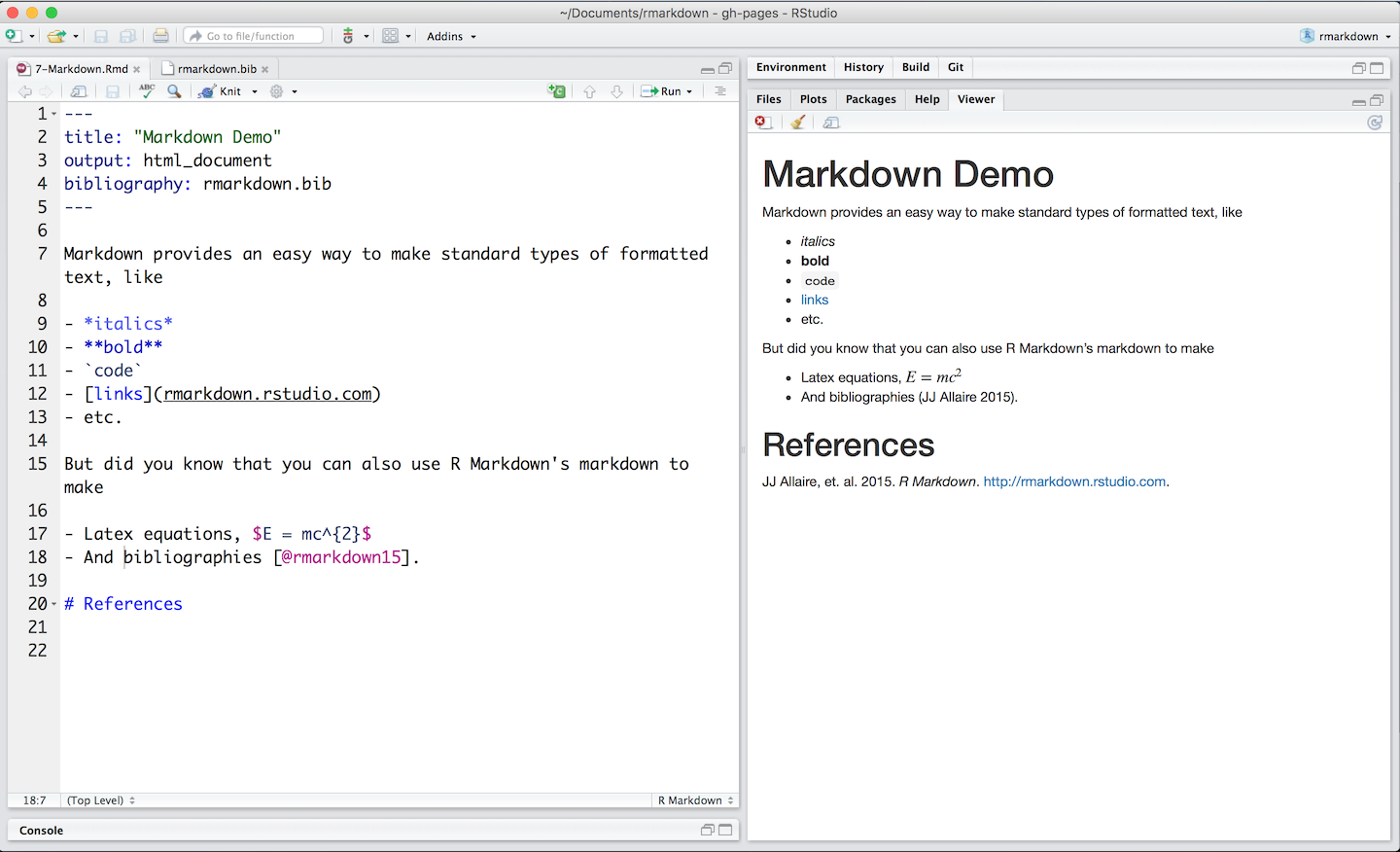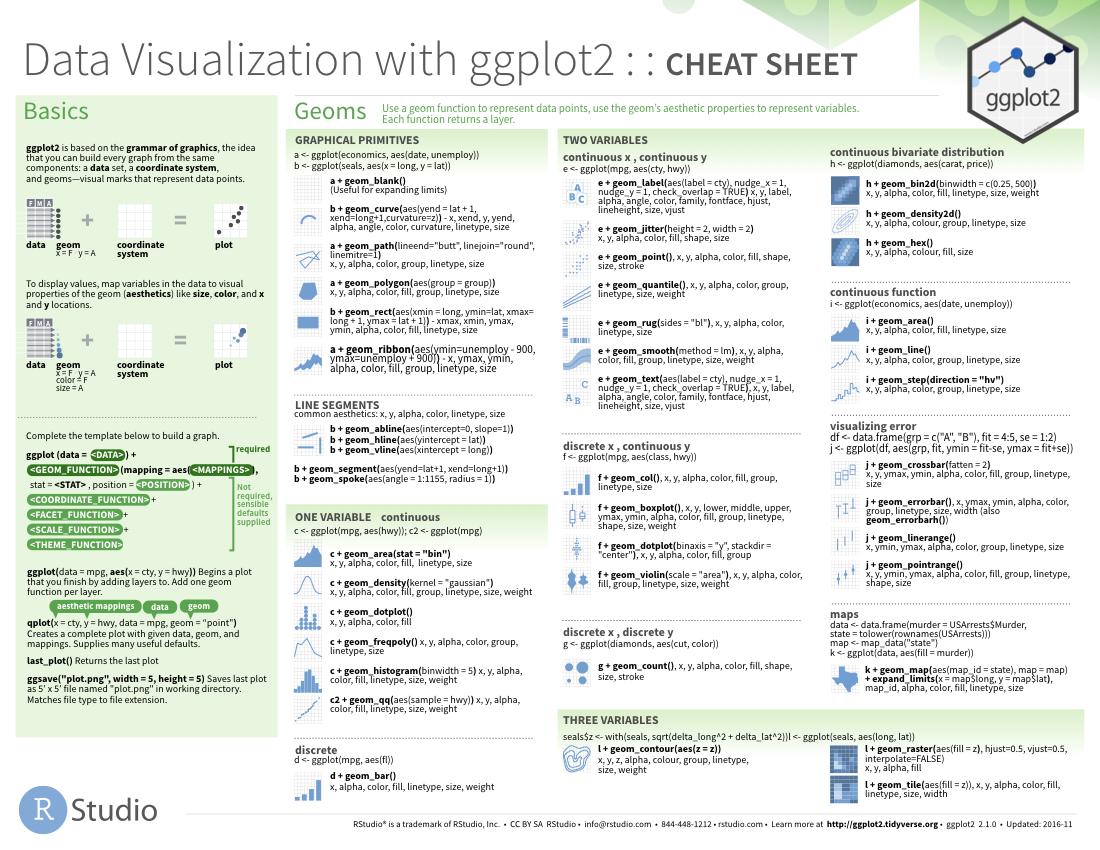Cheatsheets Use the cheatsheets that are built into the RStudio IDE to jog your memory about R Markdown. Go to File Help Cheatsheets R Markdown Cheat Sheet to open the main R Markdown cheatsheet, pictured above. Go to File Help Markdown Quick Reference to open the Markdown Quick Reference in your help pane. This lubridate cheatsheet covers how to round dates, work with time zones, extract elements of a date or time, parse dates into R and more. The back of the cheatsheet describes lubridate’s three timespan classes: periods, durations, and intervals; and explains how to do math with date-times. Bonus: R Markdown Cheatsheet RStudio has published numerous cheatsheets for working with R, including a detailed cheatsheet on using R Markdown! The R Markdown cheatsheet can be accessed from within RStudio by selecting Help Cheatsheets R Markdown Cheat Sheet. RStudio recognizes that files named app.R, server.R, ui.R, and global.R belong to a shiny app Run app Choose location to view app Publish to shinyapps.io or server Manage publish accounts Access markdown guide at Help Markdown Quick Reference Stage files: Show file diff Commit staged files Push/Pull to remote View History current branch.

In a previous post, I described how I was captivated by the virtual landscape imagined by the RStudio education team while looking for resources on the RStudio website. In this post, I’ll take a look atCheatsheets another amazing resource hiding in plain sight.
Apparently, some time ago when I wasn’t paying much attention, cheat sheets evolved from the home made study notes of students with highly refined visual cognitive skills, but a relatively poor grasp of algebra or history or whatever to an essential software learning tool. I don’t know how this happened in general, but master cheat sheet artist Garrett Grolemund has passed along some of the lore of the cheat sheet at RStudio. Garrett writes:
One day I put two and two together and realized that our Winston Chang, who I had known for a couple of years, was the same “W Chang” that made the LaTex cheatsheet that I’d used throughout grad school. It inspired me to do something similarly useful, so I tried my hand at making a cheatsheet for Winston and Joe’s Shiny package. The Shiny cheatsheet ended up being the first of many. A funny thing about the first cheatsheet is that I was working next to Hadley at a co-working space when I made it. In the time it took me to put together the cheatsheet, he wrote the entire first version of the tidyr package from scratch.

It is now hard to imagine getting by without cheat sheets. It seems as if they are becoming expected adjunct to the documentation. But, as Garret explains in the README for the cheat sheets GitHub repository, they are not documentation!
RStudio cheat sheets are not meant to be text or documentation! They are scannable visual aids that use layout and visual mnemonics to help people zoom to the functions they need. … Cheat sheets fall squarely on the human-facing side of software design.
Cheat sheets live in the space where human factors engineering gets a boost from artistic design. If R packages were airplanes then pilots would want cheat sheets to help them master the controls.
The RStudio site contains sixteen RStudio produced cheat sheets and nearly forty contributed efforts, some of which are displayed in the graphic above. The Data Transformation cheat sheet is a classic example of a straightforward mnemonic tool.It is likely that even someone who just beginning to work with dplyr will immediately grok that it organizes functions that manipulate tidy data. The cognitive load then is to remember how functions are grouped by task. The cheat sheet offers a canonical set of classes: “manipulate cases”, “manipulate variables” etc. to facilitate the process. Users that work with dplyr on a regular basis will probably just need to glance at the cheat sheet after a relatively short time.
The Shiny cheat sheet is little more ambitious. It works on multiple levels and goes beyond categories to also suggest process and workflow.
Fantasy Football Cheat Sheets Rookies

The Apply functions cheat sheet takes on an even more difficult task. For most of us, internally visualizing multi-level data structures is difficult enough, imaging how data elements flow under transformations is a serious cognitive load. I for one, really appreciate the help.
Cheat sheets are immensely popular. And even in this ebook age where nearly everything you can look at is online, and conference attending digital natives travel light, the cheat sheets as artifacts retain considerable appeal. Not only are they useful tools and geek art (Take a look at cartography) for decorating a workplace, my guess is that they are perceived as runes of power enabling the cognoscenti to grasp essential knowledge and project it in the world.
When in-person conferences resume again, I fully expect the heavy paper copies to disappear soon after we put them out at the RStudio booth.
In a previous post, I described how I was captivated by the virtual landscape imagined by the RStudio education team while looking for resources on the RStudio website. In this post, I’ll take a look atCheatsheets another amazing resource hiding in plain sight.
Apparently, some time ago when I wasn’t paying much attention, cheat sheets evolved from the home made study notes of students with highly refined visual cognitive skills, but a relatively poor grasp of algebra or history or whatever to an essential software learning tool. I don’t know how this happened in general, but master cheat sheet artist Garrett Grolemund has passed along some of the lore of the cheat sheet at RStudio. Garrett writes:
C# Quick Reference Card
One day I put two and two together and realized that our Winston Chang, who I had known for a couple of years, was the same “W Chang” that made the LaTex cheatsheet that I’d used throughout grad school. It inspired me to do something similarly useful, so I tried my hand at making a cheatsheet for Winston and Joe’s Shiny package. The Shiny cheatsheet ended up being the first of many. A funny thing about the first cheatsheet is that I was working next to Hadley at a co-working space when I made it. In the time it took me to put together the cheatsheet, he wrote the entire first version of the tidyr package from scratch.
It is now hard to imagine getting by without cheat sheets. It seems as if they are becoming expected adjunct to the documentation. But, as Garret explains in the README for the cheat sheets GitHub repository, they are not documentation!
RStudio cheat sheets are not meant to be text or documentation! They are scannable visual aids that use layout and visual mnemonics to help people zoom to the functions they need. … Cheat sheets fall squarely on the human-facing side of software design.
Cheat sheets live in the space where human factors engineering gets a boost from artistic design. If R packages were airplanes then pilots would want cheat sheets to help them master the controls.
The RStudio site contains sixteen RStudio produced cheat sheets and nearly forty contributed efforts, some of which are displayed in the graphic above. The Data Transformation cheat sheet is a classic example of a straightforward mnemonic tool.It is likely that even someone who just beginning to work with dplyr will immediately grok that it organizes functions that manipulate tidy data. The cognitive load then is to remember how functions are grouped by task. The cheat sheet offers a canonical set of classes: “manipulate cases”, “manipulate variables” etc. to facilitate the process. Users that work with dplyr on a regular basis will probably just need to glance at the cheat sheet after a relatively short time.
The Shiny cheat sheet is little more ambitious. It works on multiple levels and goes beyond categories to also suggest process and workflow.
Cheat Sheets R
The Apply functions cheat sheet takes on an even more difficult task. For most of us, internally visualizing multi-level data structures is difficult enough, imaging how data elements flow under transformations is a serious cognitive load. I for one, really appreciate the help.
Cheat sheets are immensely popular. And even in this ebook age where nearly everything you can look at is online, and conference attending digital natives travel light, the cheat sheets as artifacts retain considerable appeal. Not only are they useful tools and geek art (Take a look at cartography) for decorating a workplace, my guess is that they are perceived as runes of power enabling the cognoscenti to grasp essential knowledge and project it in the world.
When in-person conferences resume again, I fully expect the heavy paper copies to disappear soon after we put them out at the RStudio booth.
